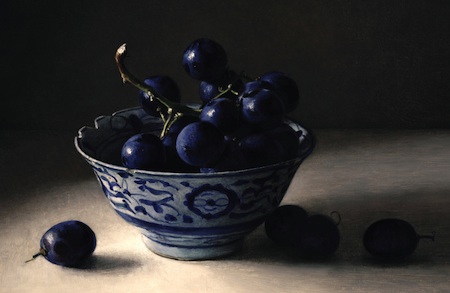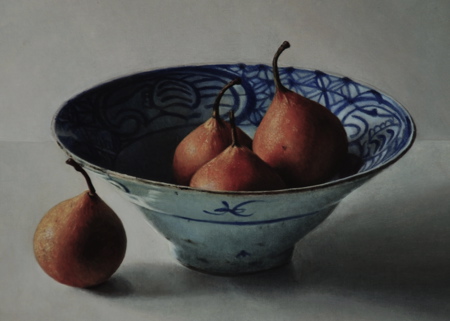Still Life and the Search for Meaning in Art and Perception
Tuesday, February 14th, 2012“Minimalist still life with fruit” — it almost seems like a kind of misguided experiment by scientists trying to understand the nature of art. Despite this, after painting a series of these pictures, I found the genre to offer all the raw material required for the deepest levels of expression.

Three Mandarins on Plate, oil on canvas, 2010
Consider this still life painting of three mandarins on a plate. The picture is an antidote to the 17th century vanitas genre and its gloomy obsession — emptiness amidst plenty. The picture above has a frank openness and confident simplicity which invite us to a rich world of present experience.
How is this achieved? I can point out four distinct factors at work:
- The objects in the picture have a convincing tactile quality, which comes from careful observation of the materials depicted. The mandarins with their coarse dimpled texture, the waxy quality of the leaves, the hard gloss of the plate, all of these details draw us in with the conviction that we can touch and experience the various surfaces.
- The robust, warm orange color of the mandarins (a color in itself quite energetic) is brought into harmony with more muted greens and blues. The color balance is positive and strong.
- Full, circular forms of the mandarins and the plate, balanced horizontally (and in depth), give the composition a sense of completeness and closure that counters any sense of emptiness.
- In parts of the picture, we see the deepest shades which submerge both color and detail. And yet, the convincing rendering of the light and color hold the shadow in check. The picture shows us the darkness, then invites us to focus elsewhere.
If we think in terms of the human visual system, we can think of the painting working on different perceptual levels simultaneously — not merely objects, but texture, color, form, space, shape from shading — to establish the evidence for its particular worldview or statement. The picture is a representation of a scene, but a scene which evokes affective depth as surely as it evokes the third spatial dimension.
In sum, we see a combination both abstract and representational factors which generate a particular emotional tone and artistic statement for the mandarin still life. The painting brings us into this world of form and meaning.
Selecting a different configuration within the genre allows for a radically different statement or worldview.

Cherries with Cup, oil on canvas, 2010
Consider this painting of cherries in a cup — which to me conveys a literal sense of the taste of cherries, a strong flavor that is almost too intense. Though stylistically consistent with the mandarin picture, this picture has a different feeling and emphasis. The picture brings us into a completely different appreciation of the present, not a calm and stable one (as with the mandarins), but an unsettling anticipation.
Where does this immediacy come from? The most obvious factor is the color. The reds of the cherries are sharper, more penetrating and aggressive than the robust, warm hues of the mandarins. The surfaces of the cherries are alive with variations of reds, like storms ranging on distant planets. Along with these colors, the smooth, glossy surfaces of the cherries reflect each other and the outside world like little mirrors, further scattering light through the scene. The stems project chaotically into space, crossing and conflicting. The cherries themselves are stacked precariously. Even where they adopt a symmetrical configuration (at the bottom), the symmetry is that of contending advisories.
With so many centrifugal elements, it seems as though the image should fly apart. And yet, there is also much holding the scene together. For all the visual fragmentation presented by the body of a given cherry, there is an overriding unity: the elegant curvature of the cherry surface, to which all details are constrained. Furthermore, there is something calming in the compositional simplicity of the foreground and background (both empty surfaces) and the cup with its reassuring regularity of decoration. And finally, the cherries, taken altogether, inscribe a stable triangular shape.
Thus, in the painting of cherries above, we are witnessing a contest between disorder and structure where the outcome is in doubt. This picture has an edgy quality, a sense of the tumultuous and the passionate barely reigned in. There is a feeling that something is going to happen.
We can see cherries in a more subdued context as well.

Cherries in Bowl, oil on canvas, 2011
In the painting above, there is a contrast between two types of darkness. The cherries are dark — it is almost as though they are windows looking out on a nighttime landscape, the highlights shining out brightly like lamps. But the dark color of the cherries (a shiny, richly dark surface) is of a very different quality from the darkness inside and on the right of the bowl, which arrises from shadow and has a more empty quality. Shadow is more prominent in this painting than in the two previous examples. The overall tone is not sad, but there is a reason for this: there is something lively about the cherries and the decoration on the bowl, which we can see circulating like a merry-go-round. These playful elements divert us, but do not hide the realization of a sombre context. The cherries are all contained, and there are not so many of them. Compared to the previous painting of cherries, full of action, we have here stillness — but what a different quality of stillness from the mandarin painting.
Darkness can also evoke mystery, which is the opposite of emptiness.

Grapes with Bowl, oil on canvas, 2011
These grapes are like deep pools of water, veiled with a vulnerable layer of mist. A dramatic light reflects from the surface, but does not penetrate the depths. The intensity of the light, paradoxically, strengthens the shadows across the scene. On the right we see grapes silhouetted in shadow, yet we know there is more to them than these simple dark shadows. The darkness here is more comforting than sombre. The mandarin painting above presented a warm openness. Here we have a sense of a hidden depth of meaning beyond our immediate reach, but the suggestion of its existence is reassuring, almost exhilarating.
If minimalist still life were really nothing more than a representation of some pieces of fruit and ceramic, it would be an infinitely mundane genre. As we have seen, quite the opposite is true. In the four preceding examples, we have witnessed a broad range of feeling and meaning. These different statements arise from all aspects of the pictures — from specific details and local features as well as from the larger aspects of composition, i.e., from the primitive visual features as well as higher level constructs. Far from collapsing into dull representation of specific objects, the painted still life can be transcendent of the mere physical forms it depicts.

Pears with Bowl, oil on canvas, 2010
The more I come to understand this, the more ironic I find the titles of these pictures to be. “Pears with Bowl,” as a title, fails to communicate that we are looking not merely at objects, but at a scene, and that in this scene we have distinct spaces with different affective dimensions. The inside of the bowl is like a world of its own, subsuming light and darkness, the pattern on the ceramic echoing a surrounding cosmos. Outside the bowl is a separate, more austere world.
Perception is a creative force which fills in — and extends — the sparse information presented to it. When we look at a still life which depicts a certain kind of world (as with the pears above), our perception naturally extends the feeling of this painted world into the larger world we inhabit.
The intimacy of this type of still life, which presents us familiar forms from a close perspective, conceals its power. While paintings of the fantastical, the shocking, the alienating and uninterpretable (i.e., the typical contemporary art subjects) might be expected to influence the viewer more strongly, we naturally put up barriers of aversion to these, whereas the humble still life catches us unawares and thus meets much less resistance as it comes alive in our perception.